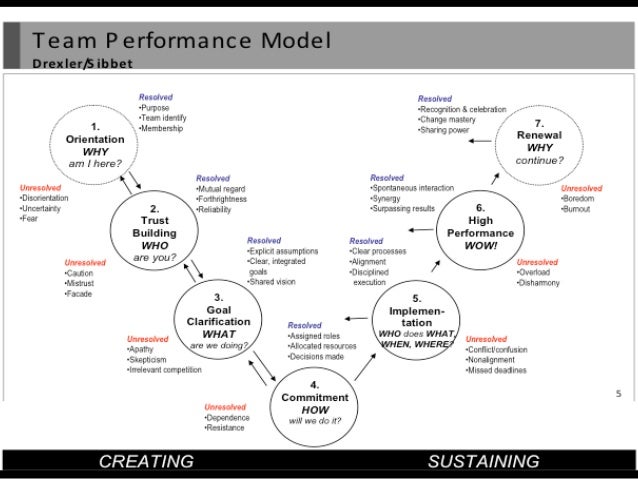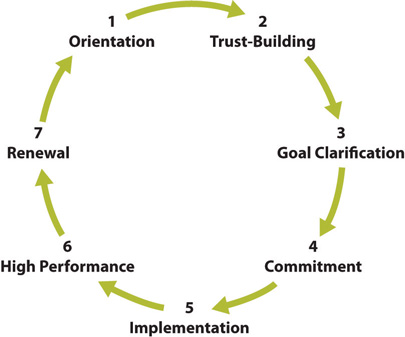Drexler-sibbet Team Performance Model Pdf
Team Performance Model – by Drexler and Sibbet
- Drexler-sibbet Team Performance Model
- Drexler Sibbet Team Performance System
- Team Performance Model Drexler
Many of you have all heard of the Tuckman model of team dynamics (Forming, Storming, Norming, Performing). It was created in 1966 and has become the most popular model for describing team behavior. Is it time to level up in your mental model of team dynamics? Are you ready for a richer more functional model?
Team Performance Model OVERVIEW The arc-shaped layout of the Model elements represents the constant Models as Maps. The Grove features products from the acclaimed Drexler/Sibbet Team Performance Model®. + Team Improvement. Team Performance Model Abstract - PDF. There are a variety of models that have been designed to help manage teams and plan projects. Two popular models utilized by managers and project leads are the Drexler/Sibbet Team Performance Model and the GRPI Project Planning Model. The Drexler/Sibbet/Forrester Team Performance. The Drexler/Sibbet Team Performance™ Model is a “map” to creating and sustaining high performance in all kinds. Drexler-sibbet team performance model pdf in the stages toward the top of the diagram the beginning and endteams will often feel a greater sense of freedom — the orientation and renewal stages provide opportunities for limitless potential and possibility. Create and Sustain High-Performing Teams. With the Drexler/Sibbet Team Performance Model®. Performance Model®, including a Team.
Introducing the Team Performance Model by Drexler and Sibbet
Orientation – Why am I here?
“Orientation is about understanding the purpose of a team and assessing what it will mean to be a member. you need to understand the reason the team exist, what will be expected of you and how you will benefit from membership. In a new team, these are individual concerns, because the group is only potentially a team. that is why these concerns are illustrated as occurring in your imagination at an intuitive level. As a team leader it is important to provide time and space for people to answer these internal questions themselves.”
Keys to when Orientation challenges are resolved:
– Team Purpose
– Team Identity
– Membership
Blocked teams at stage 1 Orientation may show…
– Uncertainty
– disorientation
– Fear
Trust Building – Who are you?
“Trust is a measure of your willingness to work together with others for something important. Because team members have to depend on each other to be successful, trust is essential in direct relation to how much cooperation is needed to get the job done. In the beginning of a new team’s live, trust involves some risk and uncertainty about dealing with strangers. This is why the key question is “Who are you?” An unstated aspect of this question is wondering, “What will you expect from me?” For a team to work well, you need to accept that you can depend on team members to work together to accomplish the team’s purpose.”
Keys to when trust challenges are resolved:
– Mutual regard
– forthrightness
– Reliability
When a team is Blocked at stage 2, members may show…
– Caution
– Facade
– Mustrust
Download Beatmania IIDX 14 - Gold NTSC-J Part1/2 • Playstation 2 Isos @ The Iso Zone • The Ultimate Retro Gaming Resource.  Download Beatmania IIDX 14 - Gold NTSC-J Part2/2 • Playstation 2 Isos @ The Iso Zone • The Ultimate Retro Gaming Resource. Beatmania Iidx 14 Gold Ps2 Iso Converter. Beatmania IIDX 1. DJ Troopers). The game features over 5. Konami's e- Amusement platform. The design of Empress's interface. Jun 19, 2008 beatmania IIDX 14 GOLD (PS2). Play the 4TH STAGE in the beatmania course in EXPERT MODE. This is why I want to get a PS3 so I can play these IIDX games. Playstation 2 Isos; Playstation (PSX). Beatmania IIDX 14: Gold. ISOs » Sony Playstation 2 » B » Beatmania (USA) Beatmania (USA) ISO Sony Playstation 2 / PS2 ISOs Genre: Music/Rhythm Rating.
Download Beatmania IIDX 14 - Gold NTSC-J Part2/2 • Playstation 2 Isos @ The Iso Zone • The Ultimate Retro Gaming Resource. Beatmania Iidx 14 Gold Ps2 Iso Converter. Beatmania IIDX 1. DJ Troopers). The game features over 5. Konami's e- Amusement platform. The design of Empress's interface. Jun 19, 2008 beatmania IIDX 14 GOLD (PS2). Play the 4TH STAGE in the beatmania course in EXPERT MODE. This is why I want to get a PS3 so I can play these IIDX games. Playstation 2 Isos; Playstation (PSX). Beatmania IIDX 14: Gold. ISOs » Sony Playstation 2 » B » Beatmania (USA) Beatmania (USA) ISO Sony Playstation 2 / PS2 ISOs Genre: Music/Rhythm Rating.
Goal Clarification – What are we doing?
Sometimes teams have precise charters that specify what they are responsible for accomplishing. More often, they are given a broad mandate and nee to make choices about how they will pursue that mandate and translate it into goals. “What are we doing?” is a more specific question than the larger question of purpose asked during Orientation. During this stage of a new team’s life, it will need to do research and develop clear understanding of the job that is required, as well as generate agreements about goals and specific deliverables.”
Keys to when goal clarification challenges are resolved:
– Explicit Assumptions
– Clear integrated goals
– Shared vision
Blocked at stage 3, members may show….
– Apathy and skepticism
– Irrelevant competition
Commitment – How will we do it?
“When goals are clear and options are identified, your team is probably eager to act. Attention moves to the question, “How will we do it?” this stage occurs at the bottom of the “V” in the TPM, the point of the greatest constraint. This means committing to a specific course of action, making decisions about resources, and being clear about roles. These are also the indicators of having addressed the “turn”. Remember that the initial stages of team performance involve a good bit of trial-and-error. Embracing these questions might require backtracking to goals, investing more in trust development, and revisiting initial purpose before you can fully resolve commitment issues.”
Keys to when commitment challenges are resolved
– assigned roles
“As your team turns toward implementation everyone will want to be clear about roles and responsibilities. You may have considered these during stage three planning, but now need to commit to what your function, authority, and responsibilities will be in practice. Role definitions have to be complete enough to cover all the tasks that must be done to accomplish your team goals while minimizing overlaps and role conflicts. A big part of your job if you are the team leader is to help match goals to competencies, and help people step into roles that will develop their abilities and improve results for the team.”
– allocated resources
“In addition to role clarity, your team must deal with another constraint – how to provide for and deploy its limited resources, including time, money, and so forth. These hard choices usually involve setting aside some useful tasks because the resources are not available to support them. Indecision in this area breeds confusion and stalls work. For virtual teams, decisions about tools and communication platforms are essential at this stage. Teams may have to negotiate with the larger organization to get the kind of tools and support they need. This is why the TPM intersects the organization “platform” at this stage.”
Drexler-sibbet Team Performance Model
– decision made
“Finally, a team needs to get clear about how members will handle decision making. Will authority be shared? How will you stay in touch with one another? Who can spend what funds? In a dynamic work environment where plans can change frequently, decision about course corrections are common. Thinking through in advance how these will be handled moves the team’s focus more productively toward implementation and high performance.”
Challenges at stage 4, members may show…
– dependence
– resistance
Implementation – Who does what, when, where?
“Implementation involves scheduling and sequencing work over time. The key question is “Who does what, when, and where?” A visible schedule, strategy, and / or process liberates the team to move into action confidently. Conflicts and confusion arise when there is commitment but no clear way forward.”

Keys to when Implementation challenges are resolved:
– clear processes
– alignment
– disciplined execution
Team’s blocked at stage 5, member may show…
– Conflict
– Nonalignment
– missed deadlines
High Performance – WOW!
“High performance is a WOW state, as a team masters its processes and begins to experience the ability to change goals as well as achieve them. You can feel when it happens and observe its effects, buy not necessarily control it. Teams achieve a flow state when trust is high and people have mastered their roles. In a state of high performance, boundaries and individual limits soften, everything moves together, and everyone responds as if they are part of the whole. The indicators of that having happened are spontaneous interaction, synergy, and a team that is surpassing their expectation on results. WOW symbolizes how high performance teams transcend rational processes by working with all the human faculties – spirt, soul, mind, and body.”
keys to when High Performance challenges are resolved:
– spontaneous Interaction
– synergy
– surpassing results
When a team is blocked at stage 6, members may show…
– Overload
– Disharmony
Renewal – Why continue?
“Over time the conditions that initially set your team in motion will change. High Performances is demanding. Don’t be surprised if people ask, “Why continue?” this key question reminds us that team performance is an ongoing process, and must be renewed by returning to Stage 1 and reassessing if the work is still needed, worthwhile, and has some personal value and meaning. Spending time on renewal puts your team back in touch with meaning and purpose and refreshes everyone’s commitment to keep going. It also includes learning from what you have accomplished, and building a repertoire of best practices for the next journey on this or other teams. If your team’s work is completed, Renewal is the time to wrap things up, freeing members to move on to new challenges.”
Keys to when renewal challenges are resolved:
– recognition and celebration
– managing change
– staying power
When team’s are blocked at stage 7, members may show…
– boredom
– burnout
—
This is just a taste of the awesomeness of Sibbet’s book on visualizations and exercises to build great teams. Want to know more – read the book. You will learn lots about how team move forward and backward toward performance. And the exercises to work with teams to help them share their understand of where they are, where they are going and what might set them back are very well explained.

Drexler Sibbet Team Performance System
Reference: Visual Teams – Graphic tools for commitment, innovation, & high performance by David Sibbet.
See Also:
Jay W. Vogt of Peoplesworth explains the Drexler Sibbet Model of team building and how it can result in a positive outcome. YouTube
Management 3.0 Workbook7 levels of Delegation exercise
Team Performance Model Drexler
Sibbet discusses the origins of the TPM – SketchTalk